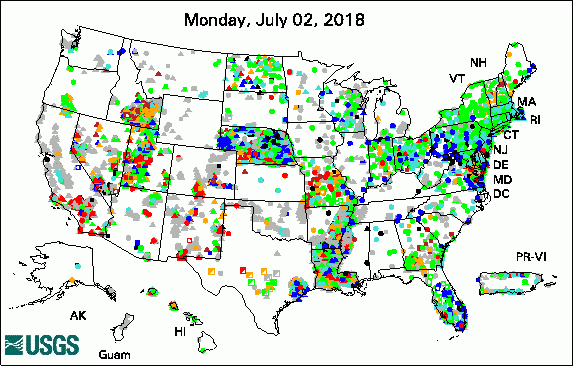USGS Groundwater Information
|
USGS Groundwater Information > August 1, 2018 Highlights USGS Monthly Groundwater News and Highlights: August 1, 2018To continue to get the latest highlights, we recommend you subscribe to get the latest USGS groundwater news and science sent to your inbox every month! Feature: Secondary hydrogeologic regions of the conterminous United StatesUSGS previously identified and mapped 62 Principal Aquifers in the U.S., with 57 located in the conterminous states. Areas outside of the Principal Aquifers, which account for about 40% of the conterminous U.S., were collectively identified as "other rocks." A new study from the USGS subdivides this large area into Secondary Hydrogeologic Regions. Secondary Hydrogeologic Regions generally consist of low permeability rocks or deposits, but can include locally productive aquifers. Together with the Principal Aquifers of the U.S., the Secondary Hydrogeologic Regions provide a comprehensive, national-scale hydrogeologic framework for assessing and understanding groundwater systems. ![Map of groundwater withdrawals in the United States in 2015 [ Map of Secondary hydrogeologic regions of the conterminous United States ]](images/feature/20180801_SHRmap.png)
Figure: Secondary hydrogeologic regions of the conterminous United States. Source: Belitz and others, 2018. Figure is in the public domain.  
The USGS Active Groundwater Level Network includes about 20,000 wells that have been measured by the USGS or USGS cooperators at least once within the past 13 months. The animation shows a daily snapshot of water-level statistics in the network for July 2018. Credit: USGS. The image is in the public domain. USGS Groundwater-Related PublicationsWhat can trees tell us about the air we breathe at home? (07/31/18) Secondary hydrogeologic regions of the conterminous United States (07/19/18) Idaho water use, 2015 (07/20/18) Water budget of the upper Chehalis River Basin, southwestern Washington (07/17/18)
USGS Groundwater Flow and Transport Model Data ReleasesNote: The following links take you to data.doi.gov iTOUGH2-EOS7C model used to analyze multiphase flow and underpressured shale at the Bruce Nuclear Site, Ontario, CanadaMODFLOW-NWT inset models from the regional Lake Michigan Basin Model in support of groundwater age calculations for glacial aquifers
Field Photo of the MonthDid you know that USGS summer interns are gaining first-hand experience doing science at field sites, laboratories, and offices across the Nation this summer? In this photo, intern Kimberly Moore monitors wind conditions while providing field support for drones being used to study interaction between groundwater and surface water in the Elk Mountain Range in July 2018. Kimberly is interning with USGS to work on applied hydrogeophysics through the National Association of Geoscience Teachers (NAGT)/USGS 2018 Cooperative Summer Field Training Program. Archive of Past Highlights: |